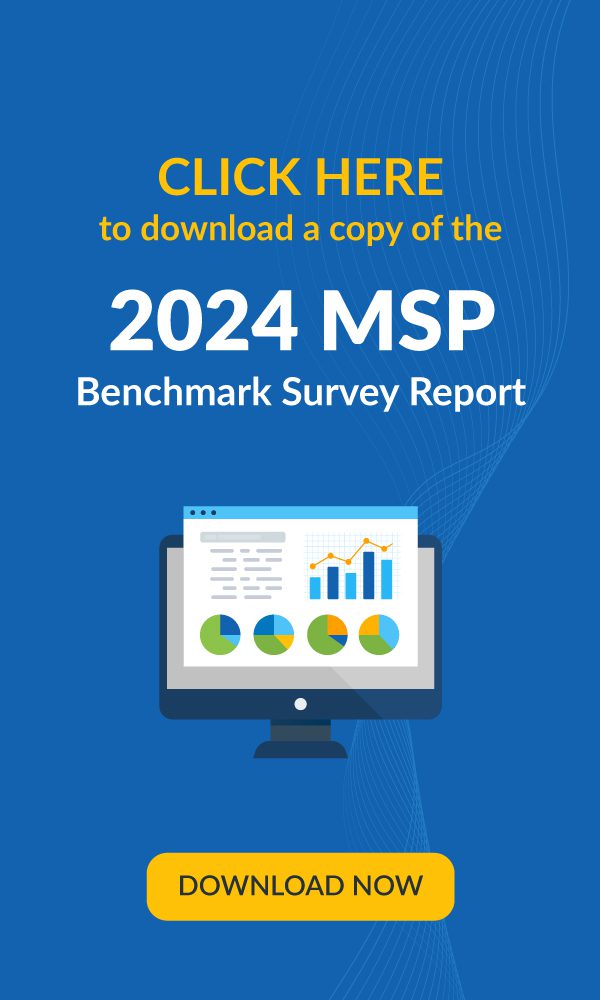Many MSPs lose valuable time juggling between disjointed tools to run their business, which decreases productivity. As a result, they end up spending more time getting their business under control than actually running it. A professional services automation (PSA) solution helps MSPs streamline their business operations so they can control costs, boost technician efficiency and increase productivity. In this blog, we’ll discuss the features and benefits of PSA tools as well as how businesses can identify the solution that’s right for them.
What is Professional Services Automation?
Professional services automation refers to the use of technology or modern solutions by professional service providers to improve business efficiency, lower overhead costs and increase profitability. This involves consolidating fragmented data and processes within a single platform, like a PSA tool, automating repetitive tasks, and using the data and insights provided by the tool to make better business decisions. By utilizing professional services automation, MSPs can manage their business as efficiently as their bigger counterparts. Given their budget and cost constraints, a PSA tool helps MSPs maximize the use of their limited resources so they can serve more clients without incurring additional expenses.
Companies that charge by billable hour benefit most from professional services automation since they otherwise tend to lose money and time keeping track of these details. Many of these companies leave a lot of money on the table and, along with other inefficient processes, their costs spiral out of control. By automating and streamlining these business processes that are hard to track manually, PSA tools help organizations optimize revenue and reduce costs, ensuring maximum profitability.
This tool is great for businesses that want to scale in a cost-effective way.
What are professional services?
Businesses rely on a variety of services to operate efficiently. Not all these services can be run in-house since they do not have the expertise or the budget to hire people who specialize in them. As a result, small businesses enlist the help of professional services companies to do the job for them, either on a retainer basis or on a single project basis.
Professional services do not involve the physical sale of products, but rather the application of a specific skill in which the provider has specialized training and, in some cases, a license to practice. Examples include accounting firms, legal services, marketing agencies, consulting firms, recruiting services, event management and IT firms, to name a few.
Managed service providers also fall under the category of professional services. Although some MSPs offer hardware and software products, they primarily make money by selling their technology knowledge. Modern MSPs work for their clients in more ways than just providing break-fix services. Based on the needs and problems of their clients, they recommend the best IT infrastructure design and manage it for them on a day-to-day basis. In addition, they serve as IT consultants recommending the best tools, solutions and courses of action to their customers. These days, MSPs are more proactive when it comes to IT management and client servicing. Rather than deal with challenges as they arise, they anticipate them and take appropriate measures to nip them in the bud.
What does PSA software do?
A modern PSA tool combines the functions, functionality and capabilities of core business solutions into a single platform so that companies can perform project management, resource management, ticketing, quoting, billing and customer service all in one place. As a result, completing business-critical functions along with operational and administrative tasks becomes a breeze, providing a significant increase in efficiency.
A PSA tool breaks down the information silos and barriers that come with working with disparate, disjointed tools. The system centralizes project details and data in one location, creating transparency at work, which allows employees to reduce errors and solve problems in real time. The ability to gather all of the important data in one tool allows employees and managers to better plan, manage and measure the success of various projects. Additionally, it allows businesses to channel more resources towards more profitable projects and eliminate the ones that are unprofitable.
In addition, a PSA tool also enables employees from almost all departments to automate repetitive tasks, which helps to save time. Service desk managers can use this feature to address the unprecedented increase in service requests as a result of remote and hybrid working environments. Technicians can minimize errors and increase service ticket resolution turnaround times by automating common service requests.
For MSPs, PSA enables seamless workflow integration with IT documentation and remote monitoring and management (RMM) tools. In this way, technicians can enhance the functionality of three key tools they use and supercharge their business.
Here are a few of the functions performed by a PSA tool:
- Accounting
- Billing
- Client Access
- End-to-end customer journey
- Invoicing
- Project management
- Quoting
- Service desk
- Team collaboration
- Time and expense tracking
What are the benefits of PSA software?
Standardizing work is one of the most important benefits of using a PSA solution. Standardization simplifies business processes and brings everyone on the same page. By doing this, departments and employees can communicate clearly, employees have a greater understanding of what needs to be delivered and tracking projects becomes easier. In addition, it speeds up everyone’s work, reduces cost leakage, eliminates other operational inefficiencies and helps the business grow at a rapid rate. In this section, we’ll explore some of the key benefits of using PSA software.
Increased Revenue and Profitability
Profitability is the goal of every business, and it can be achieved either by expanding the current portfolio and winning more clients or by streamlining business operations. Winning more clients and contracts is good, but the costs associated with it can eat up margins. Since a PSA tool helps with both resource and project management, it helps to optimize resource use and curb wastage, thus increasing revenue and profitability. In addition to maximizing project monetization, PSA tools help identify and plug cost leakages in every area of the business that would otherwise go undetected. It helps improve the business on every front so that businesses can earn and save more without investing in additional resources.
Superior Project Management
With a PSA tool, businesses can manage all aspects of a project seamlessly without a hitch. The dashboard brings together the various components of a project in one easy to understand format so that all stakeholders can access any information from their console in real time. The project management functionality of a PSA also makes it easier for businesses to set milestones and schedules so that employees can meet deadlines and fulfill customer requests.
In the case of billable services, the tool ensures that clients are billed for every minute without fail and helps businesses avoid over servicing them. Even for fixed price projects, a PSA tool will help you utilize your resources optimally and maximize the earnings from each project. In addition, it ensures that all users have full visibility into the project at any point in time. As a result, it is easier for everyone to switch between tasks quickly and new employees are able to quickly take over projects from those leaving the company.
Reduced Administrative Needs
Administrative tasks are necessary to streamline work and move it forward, but they also take away valuable work time from your employees. For instance, data entry is a tedious and time-consuming administrative task. In the absence of a PSA system, employees would have to enter the same information into multiple tools for record keeping and maintaining audit trails. The result is a multitude of errors and high levels of stress in your employees. A PSA will require data entry to be done just once. Additionally, it can automate numerous administrative tasks that will boost the productivity of your employees and make them happier.
Greater Operational Efficiency
Operational efficiency is about achieving maximum output at a high level of quality using available resources. In order to achieve this, a company must optimize everything including processes, people, financials and technology. Generally, companies that use a PSA tool are more efficient and those that are operationally efficient are more profitable. If you use a PSA system wisely, it can make your business run like a well-oiled machine that can be scaled easily. By automating repetitive tasks in today’s digital age, businesses can stay competitive by reducing costs and time. In addition, it relieves people of the administrative burden, allowing them to concentrate on business-critical tasks.
Improved Customer Satisfaction
Keeping a few clients happy with a small group of technicians is easy. But as companies scale, they don’t all have the resources to hire more employees. In some cases, this keeps companies from acquiring more clients since they fear that they won’t be able to provide the same quality service to everyone. A PSA tool enables a structured and standardized approach to the professional services delivery lifecycle so that customers always rate the business five stars. Moreover, the tool helps businesses track every interaction with customers. Employees can monitor all past communications quickly and provide quick resolutions for customer requests. Using customer insights provided by PSA, companies can even increase revenue by cross-selling and upselling higher margin services to existing customers.
What features should PSA software have?
Due to the number of PSA tools available in the market, businesses often find it difficult to find one that meets their specific requirements. In order to pick a modern PSA solution that is right for you, you need to consider a number of factors. The following are some of them:
- Ease of use: By implementing a modern PSA solution, you can complete a wide range of tasks effortlessly. Whether you need to create a contract, resolve a ticket, prepare a quote or generate key customer reports, a PSA should allow you to do it all from one screen without switching between multiple interfaces.
- End-to-end automated billing: You can set up billing automation to automatically approve and bill things like recurring services from contracts or labor hours from tickets. In addition to automating the complete billing process, including everything from posting items to invoicing, you can also reconcile the services offered based on device, user and cloud counts.
- Comprehensiveness (end-to-end solution): A complete PSA solution should include a wide range of capabilities and features to handle all your operations and administrative needs. The system should allow you to manage the end-to-end journey of your customers from quotation and contract through to service tickets, projects and billing. It should contribute to the bottom line and smooth out operations.
- Service desk: A service desk directly affects the customer retention rate for an MSP and ensures higher system uptime for their clients. Choose a PSA tool that provides advanced ticket resolution automation and helps you make measurable enhancements to your service desk capabilities. Here are some ways a PSA can benefit your service desk:
- Efficiency: An efficient service desk not only speeds up response times and resolutions, but also enhances customer satisfaction by providing high levels of service.
- Automation: A modern PSA solution enables auto-remediation of incidents by automatically running RMM scripts based on endpoint alerts without needing technician intervention.
- Documentation: In addition to an RMM, a PSA should integrate seamlessly with your IT documentation tool so that you can quickly find the documentation and knowledge you need to resolve tickets.
- Streamlined quoting: A PSA solution should allow you to create quotes quickly based on readily available pricing and product information. Once the quote is approved, you can link it directly to your services contract in PSA and begin delivering your services seamlessly.
- Customer relationship management (CRM): A modern PSA tool either integrates with popular CRM tools or incorporates their functionality. Typically, CRM tools have all the details on clients and allow companies to identify sales opportunities, review purchase histories and interact with clients during various stages of the sales journey. The right PSA solution provides easy-to-use customer relationship management functionality that allows you to effortlessly manage accounts, fulfill customer needs quickly and ensure that the entire team works in unison.
- Effortless project management: Effective project management involves setting up and tracking multiple items, including project budget, costs, staffing assignments, task time, task dependencies and task due dates. The right PSA solution enables you to plan, track and deliver projects on time and on budget.
Who uses PSA software?
PSA tools eliminate departmental barriers and centralize processes, enabling representatives from all departments to work together toward a common goal more easily.
- Owners: By using a PSA, business owners can keep track of all projects and processes within the organization and identify areas in need of improvement so that operational efficiency can be achieved. Using real-time reports and insights, they can stay on top of problematic areas and adapt as necessary.
- Admins: The tool allows admins to automate a variety of tasks and simplify their work.
- Finance: By giving users the ability to see and manage the details of projects, time and expenses, billing, and customer interactions from a single console, a PSA solution gives users detailed insight into business agility. The finance team can automate basic billing tasks and generate accurate invoices on time so that money can be collected from clients in a timely manner. This allows the company to build a regular cash flow.
- Administration: PSA software automates a host of admin tasks that make managing and running a business easier for service providers. Employees can use the tool to simplify data entry, plan resources and capacity wisely, follow up on projects, forecast project turnover and benefit from streamlined workflows.
- Service desk personnel: The automated ticketing module in a PSA can prioritize tickets based on severity and complexity, so that technicians can take on business-critical challenges immediately. A modern PSA system can automatically create a ticket in response to an alert on an endpoint and even remediate simple issues without human intervention. With these capabilities at your fingertips, you can reduce service desk management costs significantly and cater to a growing clientele without hiring additional staff.
- Technicians: A PSA tool helps improve the efficiency and performance of technicians, meet service-level agreements (SLAs) and shapes the way IT professionals deliver their services to both internal employees and to customers.
- Service desk managers: A modern PSA tool allows service desk managers to be more proactive and flexible when responding to a variety of operational challenges.
- Project managers: Managing projects is a breeze with PSA. Since all project workflows and information are centralized, anyone working on a project can access real-time updates and information. As a result, projects continue to move forward smoothly even when technicians critical to its success leave the company.
- Sales and account management: Through PSA, the accounting and sales departments can combine their efforts for greater efficiency. In addition, the accounting team can also leverage out-of-the-box integrations with accounting software like QuickBooks® and Xero®.
What should you consider when evaluating PSA options?
In this section, we’ll focus on the considerations that businesses should make when evaluating PSA solutions for purchase.
- Billing (automated and accurate billing): Modern PSA systems eliminate this entire hassle of manually reconciling client data and give you precise details on each client account so you can facilitate accurate billing. PSA tools also accurately capture changes in costs when clients modify service plans mid-cycle. Having your services billed on time allows you to earn a steady stream of revenue and make better use of all your earnings. Billing accurately also boosts your MSP’s credibility.
- Reporting: Modern PSA solutions offer powerful reporting that provides real-time insights and aligns your service desk with world-class standards. They allow you to utilize out-of-the-box dashboards and reports to highlight metrics that matter.
- Mobile access (mobile app): Whether you are onsite or out and about, you need to have the flexibility to access tickets, view asset information or even run automation scripts from your PSA mobile app so you can service your clients from anywhere.
- Pricing: Take into consideration the initial implementation cost, the integration cost, the migration cost, the per-user cost, the module cost, the cost of modifying configuration to meet future needs and so on before you make your decision.
- Migration and implementation: An effective migration strategy will help you avoid obstacles, minimize risks and give you more control over the process. Here’s a checklist that you must follow to ensure a successful migration and implementation of a modern PSA solution.
What is PSA software for MSPs?
A PSA tool helps businesses enhance service delivery, meet service level agreements (SLAs), improve customer experience, get real-time data insights for better decision-making, simplify project planning and execution, minimize administrative costs and simplify billing among other benefits.
With a modern PSA solution, MSPs can run their businesses with the same efficiency as their bigger competitors. It provides them with automation capabilities, which allows them to streamline mundane tasks and free up more time for their technicians to meet and service clients.
Another big benefit of a PSA tool for MSPs is integration. By integrating IT tools, MSPs can streamline their operations, cut back on unproductive time and lower their operating costs.
What is PSA integration?
MSPs can improve customer service, increase turnaround time on administrative tasks and make better use of their databases by integrating core tools. Integration also enables MSPs to switch between applications effortlessly, which simplifies and streamlines their work, saving time and money.
A whopping 96% of MSP respondents to the 2022 Kaseya Benchmark Survey said they believe integrating core applications like RMM, PSA and IT documentation is important to their business, and around 78% said that it helps drive bottom-line profits.
Superior PSA with Kaseya BMS
Kaseya BMS is an end-to-end PSA solution that enables MSPs to turbocharge their productivity. It enables MSPs to run their entire business, from ticketing and project management to quoting and billing and more, all in a modern and intuitive platform. In addition, it connects with all tools that you already use, including popular office, billing, accounting and security tools so that your MSP can manage its business like a pro and take it to new heights.
BMS is the fastest-growing PSA in the market, with 65% year-on-year growth, and is used by leading MSPs around the world to run their businesses efficiently. It boasts a documentation-first service desk that will increase tech momentum by 25% so your technicians can resolve every ticket more accurately and faster.
Get rid of your old and outdated PSA today and onboard to BMS in the easiest way possible. Request a demo now!



